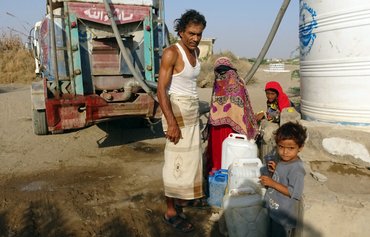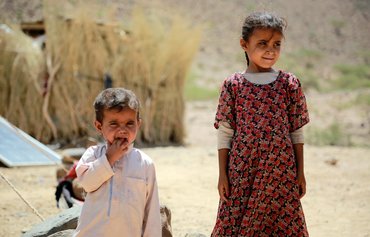SANAA -- Displaced from Yemen's al-Hodeidah port three years ago, Bandar Salem and his family of four now live in a tent erected on a sidewalk next to a park in central Sanaa, exposed to the elements.
The protracted war that broke out when the Houthis staged a coup in Sanaa in September 2014 cost the family their home and their livelihood, leaving them reliant on humanitarian aid that is often stolen or diverted by the Iran-backed group to feed its own fighters.
Salem and his wife welcomed a new baby less than two weeks ago but cannot provide their newborn enough milk, or the family enough food to eat.
"I collect plastic boxes and bottles and earn 600 YER ($2.40) a day," he said.
![Bandar Salem stands next to his family tent in Sanaa in a picture taken in August. [Haitham Mohammed/Al-Mashareq]](/cnmi_am/images/2022/09/08/36847-yemen-sanaa-displaced-600_384.jpg)
Bandar Salem stands next to his family tent in Sanaa in a picture taken in August. [Haitham Mohammed/Al-Mashareq]
![Bandar Salem, seen here in August, says he ekes out a meagre living by collecting empty plastic boxes and bottles. [Haitham Mohammed/Al-Mashareq]](/cnmi_am/images/2022/09/08/36849-yemen-displaced-population-600_384.jpg)
Bandar Salem, seen here in August, says he ekes out a meagre living by collecting empty plastic boxes and bottles. [Haitham Mohammed/Al-Mashareq]
Although they face difficult circumstances, Salem and his family appear to be faring better than his brother Mahdi, who sleeps on a mattress next to Salem's tent as he seeks to provide for his children, who still live in al-Hodeidah.
Mahdi said he used to work at al-Hodeidah port but lost his job and was forced to travel to Sanaa "in search of work to provide for my seven children".
4.3 million displaced
Famine is looming amid the ongoing conflict, according to the Studies and Economic Media Centre, a Yemen-based non-governmental organisation.
Yemen "has the fourth largest population of internally displaced persons (IDPs) in the world", according to a United Nations High Commissioner for Refugees (UNHCR) report published in August.
The number of Yemeni IDPs is estimated at 4.3 million, the report said, adding that the country also hosts 95,815 refugees and asylum seekers, mainly from Somalia and Ethiopia.
According to the report, some 286,000 Yemenis were displaced in 2021, and close to 40,000 have been forced to flee their homes since January 2022.
After seven years of devastating conflict, about 23.4 million Yemenis (73% of the total population) rely on humanitarian aid to survive, it said.
Najeeb al-Saadi, director of the Executive Unit for IDP Camp Management, told Al-Mashareq more than three million IDPs live in areas controlled by the government, while the rest live in areas controlled by the Iran-backed Houthis.
IDPs make up 13% of the total population of Yemen, he said.
Yemen's humanitarian crisis
"The movement of IDPs from urban communities, such as Sanaa and Ibb, to economically fragile provinces that do not have adequate service infrastructure, such as Marib, Hadramaut and some coastal districts in al-Hodeidah and Taez, has compounded Yemen's humanitarian crisis," al-Saadi added.
The recent torrential rains in Yemen damaged all IDP camps throughout the country, according to the Executive Unit for IDP Camp Management.
But the camps in Marib were hit the hardest, as the rain washed away a number of them altogether, the unit said.
Floods in Marib destroyed thousands of shelters, adding that its medical teams provided assistance to those afflicted by the flooding, said the World Health Organisation (WHO) on August 18.
The WHO also has set up 34 observation posts for detecting potential epidemics.
With 3.15 million IDPs and its own population of 450,000, Marib suffers from epidemics as a result of overcrowding, said Ahmed al-Abadi, director of the health office in Marib province.
"The humanitarian suffering was exacerbated by heavy rain that turned into floods," he added, pointing out that IDPs live in fragile camps that lack adequate sanitation.
Rapid tests have recorded 188 cases of cholera and 180 cases of dengue fever, as well as cases of malaria, al-Abadi said.
Increasing displacement
IDPs "are the most vulnerable group in Yemen", said economist Abdul Aziz Thabet, calling on concerned government agencies and international organisations to make "concerted efforts to serve and rescue them".
Seasonal rain destroys displacement camps every year, especially in Marib, where many camps are situated on floodplains, he told Al-Mashareq.
The lack of funding from international organisations and the rise in global food prices amid Russia's invasion of Ukraine have compounded the suffering of IDPs, who depend almost entirely on food aid, he said.
The number of IDPs will likely grow because of the ongoing war, famine, poverty and the continuous deterioration of living conditions in Yemen, he added.
Meanwhile, he said, a decrease in aid has forced an increasing number of Yemenis to move out of their homes in order to become eligible to access the aid distributed among the displaced population.

![Bandar Salem's wife holds the couple's new baby inside their tent in Sanaa in August. [Haitham Mohammed/Al-Mashareq]](/cnmi_am/images/2022/09/08/36846-yemen-displaced-tent-600_384.jpg)






